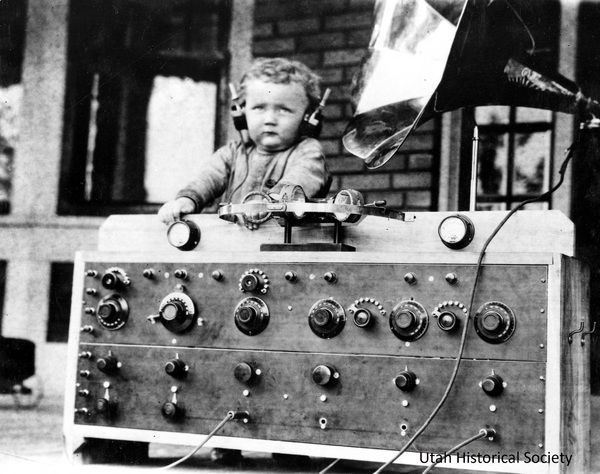Dublin Core
Title
Description
“Hello, hello, hello! This is KZN. KZN, the Deseret News, Salt Lake City calling. KZN calling! Greetings!”
In 1922, these words crackled over the airwaves emanating from one of Utah’s first radio stations. Although radio was nothing new in big cities like New York or Chicago, few broadcasters existed in Utah and nearly no one owned a radio receiver. Shortly after KZN’s initial broadcast, radio sets were installed at a rapid rate in Utah homes. And as radios became more common, listeners were eager to hear news and cultural programming in real time. Radio technology bridged the gap between communities separated by distance, offering people a way to connect through shared information and culture.
KZN wasn't Utah's only radio station. Several popped up during the early decades of the twentieth century, although very few survived the 1920s. Early on, KZN aired programs daily for 30 minutes. The station soon lengthened the broadcast time to an hour and a half each evening. Listeners from all over Utah -- and even neighboring states! -- wrote to the station expressing joy at listening to the broadcast.
At first, KZN listeners heard scripture and religious messages, but content soon broadened to include concerts and dance music aired live from the LDS School of Music, the Hotel Utah Roof Garden, and the Dance Pavillion at Saltair. Children's programming offered songs and stories. Even comedy shows and national sports were broadcast over Utah's airwaves.
Radio quickly became more than a source of entertainment, and Utah listeners eagerly followed -- in real time -- news and current events happening in the state and nation. Public officials saw the potential to relay information across radio waves, and in 1923 thousands of Utahns around the state heard KZN's broadcast of US President Warren Harding speaking from Salt Lake City's Tabernacle. Some stations geared programming toward rural families specifically by providing market reports, weather forecasts, and other agriculturally-focused offerings.
As the popularity and accessibility of radios increased, more Utahns became connected. Isolated pockets of the state now felt part of a broader American experience that included current news, music, and pop culture. Radio technology brought communities a little closer, making vast distances seem a little smaller.
Creator
Source
See Tim Larson and Robert K. Avery, “Utah Broadcasting History,” Utah History Encyclopedia, 1994; Pearl F. Jacobson, “Utah’s First Radio Station,” Utah Historical Quarterly 32, no. 2, 1964; Yvette D. Ison, “Radio in Utah Began in May 1922 on Station KZN,” Utah History Blazer, April 1995; Anna Lola Hatton, “KZN: The Birth of Radio in Utah (1922-1924),” Utah Communication History Encyclopedia; Hillary Brady, “Connecting America: The Radio at Home,”The Golden Age of Radio in the US, Digital Public Library of America, May 2014; Barry Mishkind, “Broadcast History - Salt Lake City,” The Broadcast Archive, March 2006; Carter Williams, “How Radio As We Know it in Utah Began 100 Years Ago with the Help of a Teenager,” KSL, September 5, 2019.

